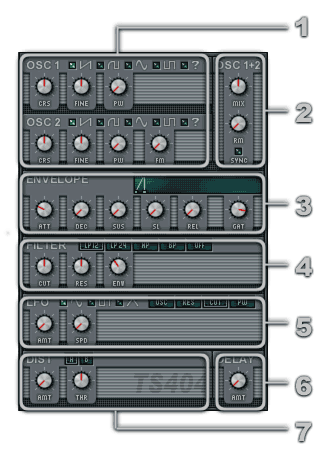CHANNEL SETTINGS
TS404 Channel Settings (TS404)
The TS404 Channel Settings page appears only in channels that hold a TS404
generator. This page holds specific properties for the TS404 generator.

1. Oscillators Section (OSC 1 & OSC 2)
This section contains the oscillator generation options. An oscillator is a
waveform with specific repeating pattern, which is then filtered to create the
way TS404 sounds. Oscillators in TS404 have a similar function as the wave sample
in the Sampler.
TS404 has two oscillators (OSC1 & OSC2). Each of them can have one of the
following wave shapes - saw, rounded
square, sine, square
and custom (wave shape buttons are at top of each
oscillator panel). Custom lets you use a short wave file to be the shape of
an oscillator. FruityLoops comes with several sample shapes that are located
in the "TS404 Shapes" folder in the Browser. You can
change the custom shape using the sample bank field in the Sampler
Channels Settings.
- Coarse Pitch Tune (CRS) -Allows you to set
the pitch of an oscillator in range of two octaves.
- Fine Pitch Tune (FINE) - Allows you to fine
tune the pitch of an oscillator.
- Pulse Width (PW) - Pulse width makes oscillator's
shape restart preliminary without finishing its phase.
- Frequency modulation (FM) - Applies frequency
modulation to the second oscillator, based on the output from the first one.
2. Oscillators Mixer Section (OSC 1+2)
- Mix (MIX) - Determines how the outputs of
OSC 1 and OSC 2 are mixed together. The more you turn that wheel left, the
more you hear oscillator 1. The more you turn it right, the more you hear
oscillator 2.
- Ring Modulation (RM) - Turning this wheel
up adds an amount of ring modulated version of the oscillators' output.
- Synchronize (SYNC) - Turning this option on
will synchronize the phases of the oscillators.
3. Envelope
Applies an envelope to the filter and the
volume of TS404. The envelope behaves much like a standard ADSR envelope, but
has some additional properties (sustain hold and gate).
- Attack (ATT) - Sets the attack value of the
envelope.
- Decay (DEC) - Sets the attack value of the
envelope.
- Sustain Hold (SUS) - With this wheel you can
set a period of "holding" the sustain state before release.
- Sustain Level (SL) - Sets the sustain value
of the envelope.
- Release (REL) - Sets the attack value of the
envelope.
- Gate (GAT) - Applies a gate
to the TS404 output. The wheel sets the lowest volume possible before it is
completely cut. This effect can be used to create short staccato sounds.
4. Filter
Applies cutoff & resonance filter to
the TS404 sound. You can choose among several types of cutoff and resonance
filter to be applied. Filter mode buttons are located at the top of filter's
panel.
- Cutoff (CUT) - Sets the cutoff value of the
filter.
- Resonance (RES) - Sets the resonance value
of the filter.
- Envelope Follow (ENV) - Sets the degree to
which the envelope of the TS404 is applied to the resonance value.
5. LFO Section
Controls a LFO that can modulate one of the
following properties: volume of the oscillators (OSC),
resonance (RES), cutoff (CUT)
or pulse width of the first oscillator (PW). The
buttons allowing you to select what to modulate are located at the top right
corner of the LFO panel. You can also select a shape for the LFO (sine, square
and triangle). The buttons are at the top left corner of the LFO panel.
- Amount (AMT) - Determine the amount of modulation
applied to the altered value.
- Speed (SPD) - Sets the frequency (i.e. speed)
of the LFO.
6. Distortion Section
Contains controls that allow you to add distortion to the TS404 sound. You
can choose between two distortion modes (A &
B buttons, located on top of distortion's panel).
- Amount (AMT) - Sets the amount of distortion.
- Threshold (THR) - Selects the frequency band
to be distorted. The more you turn this wheel to right, the wider the band
is.
7. Delay Echo
Turn this wheel to right to add an echo effect to the TS404. Panning, feedback
and all other echo settings are global for all TS404 channels. You can set them
through the TS404 Delay panel.

